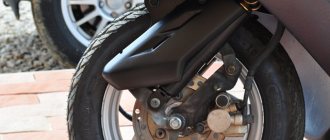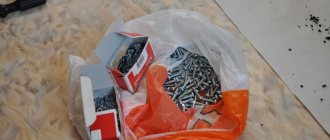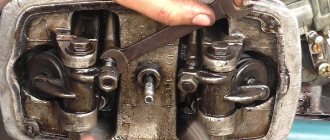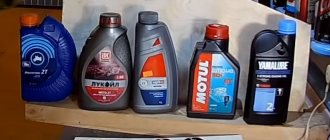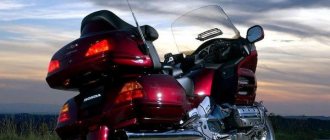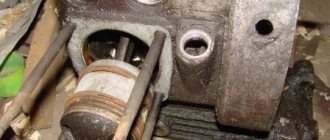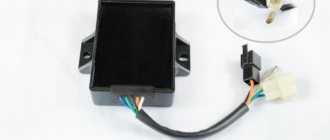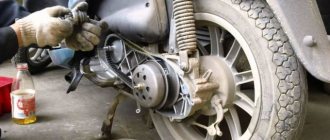One of these nuances is the pressure maintained inside the tires. The characteristic affects:
- quality and maneuverability of management;
- wheel grip on the road;
- volume of fuel consumed;
- contact patch area;
- suspension load;
- tire wear resistance;
- transport dynamics.
Neglecting the level of pressure in motorcycle tires can lead to undesirable consequences. Let's look at how to properly regulate the indicator and the dangers of insufficient or excessive pumping.
What affects motorcycle tire pressure?
Air, like any substance, expands when heated, and when cooled, on the contrary, contracts. This is also true for motorcycle tires - when hot, one level of pressure is maintained inside the tires, and when cold, a completely different one. Setting tire pressure is important, as it is responsible for the most important characteristics for any bike - both for a scooter and for a sports enduro:
- Controllability and maneuverability on dry and wet surfaces;
- The size of the contact patch is directly responsible for traction;
- Suspension operating load;
- Fuel consumption;
- Wear resistance.
In short, only properly inflated tires can effectively fulfill their task - to provide contact with the track and not lose it throughout the entire trip. Any deviation from the norm (lack or excess of pressure) is fraught with unpleasant consequences.
Calculation of the recommended value
How to use the calculator?
The calculator is working in test mode! If you find an error in the indicators or want to leave suggestions, please send them through the feedback form on the Feedback page or the VK group! Errors with evidence (photos, screenshots, links) are accepted! All information presented on the site is for informational purposes only! Thanks for understanding!
Contents
How to choose the correct tire pressure?
The front and rear tires must have different pressures, and this is important to understand before picking up a pump. The user manual of any bike always indicates the optimal pressure for cold tires, so if you measure the indicators immediately after a ride, do not be surprised that the pressure gauge will show different values - the air inside has warmed up and expanded.
The manufacturer indicates all parameters for cold tire inflation on a table on the motorcycle frame or in the user manual. They vary depending on the type of motorcycle, but, as a rule, the data varies between 2.0-2.5 Atm for the front wheel and 2.2-2.9 Atm for the rear. If you plan to put another person on the bike, we recommend inflating the tires by 0.2 atm.
| Wheel size | Pressure, front/rear, kgf/cm2 (Atm) | |
| Normal load | Full load | |
| 100/60-10 | 2,2/2,3 | 2,3/2,4 |
| 130/60-13 | 1,8/2,0 | 2,0/2,2 |
| 130/70-12 | 2,2/2,3 | 2,3/2,4 |
| 120/70-12 | 2,25/2,3 | 2,3/2,4 |
| 110/70-12 | 2,2/2,3 | 2,3/2,4 |
| 120/80-12 | 1,8/2,0 | 2,0/2,2 |
| 130/70-10 | 1,8/2,0 | 2,0/2,2 |
| 100/90-10 | 1,9/2,1 | 2,0/2,2 |
| 120/90-10 | 1,8/2,0 | 2,0/2,2 |
| 130/90-10 | 1,9/2,1 | 2,0/2,2 |
| 3,0×10 | 1,75/2,0 | 2,0/2,1 |
| 3.50×10 4PR | 2,5/2,5 | 2,6/2,6 |
Hot pressure depends on many factors, including the rider’s riding style, so they will have to be selected individually for each specific case:
- To begin, inflate the tires to 2-2.3 Atm, taking into account that for the rear tire the pressure should always be 0.3 Atm more than for the front.
- Ride at your normal pace for 10-15 minutes. The pressure in the rear and front tires should increase by an average of 0.2 atm.
- Then use the pressure gauge again: if it shows a value within the normal range of cold pressure, then you have achieved your goal. If it is higher, then lower the wheels; if lower, pump up the tires. Measure the tire pressure and adjust the amount of air inside until you achieve the result.
If you notice that immediately after the start you feel a little discomfort, then this is in the order of things. The rubber needs to warm up a little and in five minutes everything will return to normal.
Theory and practice
We all know that when air is heated, it expands, and when it cools, it occupies less volume. In order to determine what pressure a motorcycle tire should be, it is necessary to clearly determine how the vehicle will be used. Two identical tires, after active driving, may show different pressures, which is associated with warming up the air. Braking, asphalt temperature, and dynamic friction of the tire surface heat up the front and rear wheels differently.
To determine what motorcycle tire pressure is necessary for efficient and safe riding, you can use the following rules:
- Use the documentation and technical manuals that came with your motorcycle. Each manufacturer, in order to carry out certification, conducts a comprehensive assessment of the characteristics of its vehicle based on the results of tests and conclusions. As a result, a mark is placed in the technical passport or manual about the recommended pressure in the tires of the front and rear wheels.
- If you approach the motorcycle from behind, there should be a tire pressure recommendation mark on the swingarm arm. The motorcycle tire pressure table is given below:
- Make your own assessment of ride quality at different pressures and determine the best indicator.
| in English/Japanese – front wheel | 120 / 60 R17 | 2.0 |
| in English/Japanese – rear wheel | 180 / 55 R17 | 2.9 |
The tire pressure on a Minsk motorcycle may not match the pressure on sports or motocross bikes. For example, the average for motorcycles weighing up to 150 kg (without a pilot) should be: 2-2.2 ATM in the front wheel, 2.4-2.6 in the rear .
If you load your work motorcycle and move with a passenger, then the pressure can be increased to 2.6-2.9 Atm. On average, the correction per passenger should be about 0.2 Atm. Conversely, the pressure in the tires of a motocross motorcycle should be reduced when entering the track before active riding.
Correctly set pressure will not only reduce fuel consumption and extend their service life, but will also dramatically increase the controllability of the motorcycle at high speeds, when turning or overtaking.
What will be the consequences of under/excess pressure in motorcycle tires?
If you overinflate your tires, get ready for the contact patch to decrease, and along with it, the grip characteristics will deteriorate, the ride will become much harsher, there is a possibility of vibration, and the load on the suspension will also increase significantly. Riding in overinflated tires on a wet road is quite dangerous, since due to the small contact zone, the motorcycle will begin to skid when turning and brake poorly. The most unpleasant consequence will be a deterioration in strength and wear resistance. A motorcycle tire can even explode when driving on hot asphalt - one pebble can ruin everything.
Increased tire pressure is used only in two cases: if there is another passenger on the motorcycle or during long high-speed rides.
Underinflated tires have their own list of problems: their contact patch may be larger, but due to its irregular shape it wears out and deforms extremely quickly. Among the useful qualities of rubber, handling, maneuverability, directional stability and fuel consumption are seriously affected. Eventually, if you don't correct the pressure in your motorcycle tires, you will end up with cord separation. If your motorcycle has wheels with tubed tires, then insufficient inflation of the tubes will sooner or later lead to accidental dismounting.
Riding on underinflated tires is practiced only on special enduro sports motorcycles for performing off-road stunts.
However, in order to safely drive a motorcycle, it is not enough to simply set the correct tire pressure and leave it at that - we also recommend that you refer to the speed index table.
| Speed index | Maximum speed, km/h |
| A | 40 |
| B | 50 |
| C | 60 |
| D | 65 |
| E | 70 |
| F | 80 |
| G | 90 |
| J | 100 |
| K | 110 |
| L | 120 |
| M | 130 |
| N | 140 |
| P | 150 |
| Q | 160 |
| R | 170 |
| S | 180 |
| T | 190 |
| U | 200 |
| H | 210 |
| V | 240 |
| W | 270 |
| Y | 300 |
| VR | >210 |
| ZR | >240 |
| (W) | >270 |
| Z | >300 |
It is prohibited to install tires with a low speed index on high-speed motorcycles - they may not cope with the capabilities of the motorcycle, which will not lead to anything good.
Practical recommendations
To quickly set the tire pressure, you should use the rule - the pressure in the rear tire should not exceed 2.1-2.2 Atm. Pump up 2 atm in a cold state, then drive for 10-15 minutes in your usual mode on the road. Then, measure the pressure; if it exceeds 2.2 Atm, lower it; if not, pump it up. As a result of this step-by-step procedure, optimal pressure can be achieved.
A common mistake made by inexperienced bikers is overinflating the tire due to the fact that when starting to move, the pilot feels discomfort and excess tire grip. If everything is done correctly, the discomfort should go away after the air in the tire warms up. You should also not rely on the indicators of pressure gauges; sometimes inexpensive devices get knocked down and debris gets into them. In fact, on some pressure gauges the error can reach up to 0.5-0.8 Atm, which is a lot.
In addition to the level of tire inflation, it is important to pay attention to other characteristics of the wheels.
| Speed index | Maximum speed, km/h |
| A | 40 |
| B | 50 |
| C | 60 |
| D | 65 |
| E | 70 |
| F | 80 |
| G | 90 |
| J | 100 |
| K | 110 |
| L | 120 |
| M | 130 |
| N | 140 |
| P | 150 |
| Q | 160 |
| R | 170 |
| S | 180 |
| T | 190 |
| U | 200 |
| H | 210 |
| V | 240 |
| W | 270 |
| Y | 300 |
| VR | >210 |
| ZR | >240 |
| (W) | >270 |
| Z | >300 |
For example, the correct tire pressure for a Kawasaki motorcycle must also correspond to the tire speed index chart. In order to save money and due to lack of awareness, motorcycle owners can install low-index tires on motorcycles capable of accelerating to a speed of 240-280 km/h, which is strictly prohibited and can lead to tragic consequences.
Pressure is a terrible secret among professionals.
In addition to the characteristics of the tread and frame, the cross-country ability is noticeably affected by the pressure in the wheels - a factor that for some reason is usually hushed up - probably the racers keep it secret. A wise rule of thumb is to keep the pressure as high as possible and as low as necessary. High pressure reduces the risk of punctures, minimizes the possibility of damaging the rims on uneven surfaces (also reduces rolling resistance and fuel consumption approx. OSS). Reduced pressure allows for a larger contact patch, which significantly improves stability on soft surfaces. The harder the surface, the greater the pressure should be, and vice versa.
If, for example, the pressure recommended by the motorcycle manufacturer on asphalt should be 1.5 atm, then on gravel and hard ground it should be 1.2 atm, in mud 1.0 atm, and on sand even 0.8-0.6 atm . Therefore, an endurist should always have a pressure gauge and pump on hand. However, for driving at low and ultra-low pressure, you need special devices “rim lock.” Without them, the tire will most likely spin and rupture the tube at the first acceleration or braking.
Most non-sport enduro bikes do not have towing bars as standard. Nevertheless, take a close look at the rims of your motorcycle - if a bolt with a powerful nut sticks out approximately opposite the nipple, then you already have towbars. Often, instead of this bolt, there is a rubber plug in this hole. If there is not even a hole (this happens), then you will have to drill it yourself or try to enjoy driving without towbars.
If towbars are not found as standard, it’s okay - you can buy them at the first store you come across that specializes in products for motocross and enduro. If there are no such cars nearby, then you should look for them in sports sections and other places where you can buy the still numerous motocross bikes: in motocross they almost never ride at a pressure of more than 1 atm, so every motocross motorcycle is necessarily equipped with towing brakes.
However, for trouble-free driving at ultra-low pressure, towing brakes are not enough. Under such conditions, the tire experiences significant deformation and gets very hot, which can lead to frequent punctures or even destruction of the tire carcass. To prevent this from happening, the rubber must have at least a 4-layer cord (or even better, a 6-layer cord); that is, be expensive from a well-known manufacturer.
Cameras In the photo: An enhanced crossover camera from the Taiwanese manufacturer Kyoto, which promises the quality of its product no worse than that of leading brands (Equal to or better than original equipment). The type is indicated by the inscription “Reinforced Resistant).
Every motorcyclist wants his bike to be the most powerful and fastest on the road. But the point here is not only about the motorcycle and the quality of its rubber - many properties also depend on how the tires are inflated - whether the pressure is set correctly in them. It will be news to a beginner that it is not enough to simply inflate the wheels and check the pressure in them from time to time, and completely forget about its exact level. In fact, why think about how the tires are inflated?
However, for the safe operation of a motorcycle or scooter, pressure is an important thing. Why and what should be the pressure in motorcycle tires - look for the answer in our next article.
Why maintain motorcycle tire pressure?
If you think about it, the answer is quite obvious: a tire is an elastic product made of rubber, and for clear control of the route, it should not so much cushion the road as provide rigidity and stability in order to cope with all the difficulties of the road. If the tire pressure is insufficient, then a hard, durable wheel will simply turn into a piece of rubber, which will wear out more on the asphalt surface than provide the motorcycle with predictable behavior.
The pumping depends on: • The size of the contact spot; • Adhesion to wet surfaces; • Suspension integrity; • Fuel consumption.
Without properly built pressure, all these properties will either work at half strength, or in general the activity of the wheels will be detrimental to the structure of the motorcycle. Tire pressure, as an element that directly interacts with the road surface, has a direct and indirect effect on almost all components of the bike, and if you are negligent in the procedure for adjusting the pressure, then you will “earn” on your head, at best, suspension repairs and new tires .
Rules for proper pumping
First of all, we note that motorcycle tires require an individual approach to adjusting the pressure. There are no universal values, and we will have to find the right level ourselves, starting from standard values.
Any bike has factory recommended pressure values, which can be found in the instruction manual or from a table on the frame of your bike. In most cases, the tire pressure level varies from 2.0 to 2.5 Atm on the front axle, and on the rear axle it should be from 2.2 to 2.9 Atm. You should find out more accurate values yourself by looking at your documentation.
One “but”: the recommended figures are valid only for cold tires that have not yet had time to warm up during active work with the road surface. Usually after 10-15 minutes the tires heat up and the pressure increases according to physical laws. Accordingly, as soon as the rubber cools down, the pressure level naturally drops. Based on this school knowledge of physics, we will adjust the number of atmospheres in hot rubber.
Inflating the rear and front tires to the recommended parameters is only half the battle and should not stop there. The fact is that if the tires heat up during long-term driving and the tire pressure exceeds the permissible level, you will encounter the problem of overinflated tires. And this is fraught with many problems with clutch and wear.
Remember that a lot depends on the size and other characteristics of the tires. It is also necessary to take into account the conditions in which the motorcycle is used: for enduro and cross-country motorcycles, the tire pressure values will be different from those of sports and road bikes.
Our task, like all those who care about the condition of the tires, is to select a pressure in the motorcycle tires that will eliminate any additional load on the suspension, which means these optimal values must satisfy both cold and hot inflation.
We act intelligently and take our time - inflate the tires to 2-2.3 atm, taking into account that the rear tire always needs to be inflated 0.3 atm more. Then we get on the bike and go on a short ride of 10-15 minutes. Your task is to accelerate the engine to the speed corresponding to your usual style - the tires will warm up and expand, and then we will adjust the pressure in them. We stop the motorcycle and immediately use the pressure gauge: after the trip, the tire pressure should increase by about 0.2 atm for the rear and front axles. We compare the resulting numbers with the recommended value. If it has grown a lot, then you need to let the air out a little and measure again. If the value, on the contrary, is too low, pump up the tires to the appropriate level. This way you will find a balance between the pressure in cold and hot tires.
After that you need to ride a little again. Don't worry if you notice an increased roughness of the ride and excessive grip - after five minutes the tires will warm up, and comfort and smoothness will return to normal.
Danger of driving with incorrect tire pressure
You can make a mistake in two directions - overinflating or underinflating the tires. In one case or another, they will wear out more, and handling and grip on wet roads will suffer.
Only participants in professional motorcycle racing ride on overinflated tires. You can pump in an extra 0.2 atm to the rear and front axles if you plan to ride with a passenger. Low pressure levels are also used by professional athletes on enduro motorcycles during off-road racing and when performing dangerous stunts.
For an amateur motorcyclist, incorrect tire pressure will only lead to accelerated wear and ultimately complete damage to the rubber, or even peeling off part of the tread.
Monitoring the pressure in motorcycle tires is necessary primarily for the safety of the motorcyclist himself. Driving with low blood pressure does not provide any obvious bonuses for a non-professional, so there is no point in experimenting and taking unnecessary risks. For safe operation, it is recommended to use only tires that match the characteristics of your motorcycle, so do not deviate from the speed index values in the table:
The speed index is the limit within which a tire can be operated stably without loss of adhesion properties and its own integrity. Accordingly, do not use wheels on your motorcycle that do not meet its specifications.
Find the right tires for your motorcycle at BlackTyres online store. With our filters, you can easily select the right model from among products from Continental, Pirelli, Bridgestone and other renowned motorcycle tire manufacturers that guarantee the performance and reliability of their product. An accurate pressure gauge will help you maintain the required tire pressure. Place
